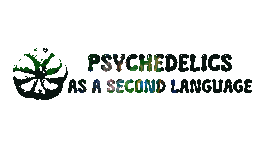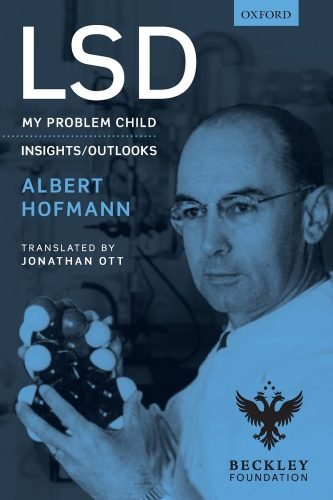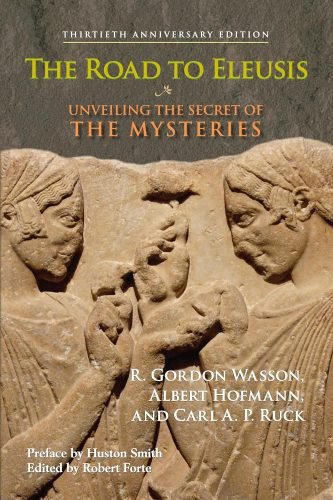LSD and the Alchemical Opus of Humanity
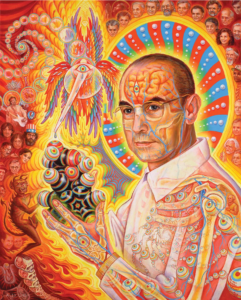
Because everything is perfect in itself,
but both a poison and a benefit to another,
God employed an alchemist,
who is such a great artist at dividing the two from each other,
the poison into his sack,
the goodness into the body.
—Paracelsus
Introduction: Psychedelic-Assisted Therapy and the Consciousness Revolution:
My writings thus far have been focused on the intersection between medicine, psychology, and astrology. With “LSD and the Alchemical Opus of Humanity”, I am initiating a series of essays that examine the medicinal value and mysterious nature of psychedelic substances. These writings represent the fruition of a long gestation period, fulfilling a motive that began twenty years ago when I first read Aldous Huxley’s essay, “The Doors of Perception”.
As always, the central concern of my writing remains therapeutic. I have chosen to write about LSD in particular, rather than the traditional and culturally-accepted plant medicines such as psilocybin mushrooms, ayahuasca, mescaline, etc. because LSD has a uniquely Western and human heritage. While traditional plant medicines have an established history of ceremonial use in indigenous cultures, LSD was born in the West in the twentieth century in the hands of a chemist. Twenty years later, LSD brought the mysticism of the East to the West and brought Westerners to the East.1
LSD straddles the divide between tradition and innovation, East and West, nature and synthesis. Plant medicines are given to us whole from the plant kingdom, but LSD is the consequence of chemistry and, as I propose, of alchemy. The alchemical attitude positions the human being in a unique relationship with nature—not only in reverence of nature but also as its steward. Perhaps the great endowment of the human being is neither an improvement upon nature nor a search for its molecular replication. Rather, the human being is handed the gift of craft, held in sanctity, and honed in consciousness.
This essay should not be misconstrued as a universal recommendation to ingest LSD. In addition to being a deeply individual matter, the use of psychedelics requires profound consideration, education, and preparation. The appropriate use of any medicine depends on a complex arrangement of individual and environmental factors (or “set and setting”). Hofmann himself lamented the use of LSD as an inebriant, advocating instead for its therapeutic use. As a natural chemist, Hofmann’s original intention was to synthesize an analeptic medicine from ergot alkaloids (which have a history of medical use). In modern medical language, an “analeptic” drug is a “restorative” drug that stimulates the central nervous system. In traditional terms, analeptic medicines are classified as “rejuvenatives” or “tonics”. The discovery of LSD’s psychoactive properties were an “accidental” revelation of a new spectrum of therapeutic effects.
Given its powerful psychic effects, Hofmann believed that LSD should only be used by psychologically stable adults in a therapeutic setting. The original monograph for LSD from Sandoz Laboratories recommends its use in “analytical psychology” and psychiatry. LSD-assisted psychotherapy has been further explored in the clinical work of Stanislav Grof and its process is also detailed in Blewett’s Handbook for the Therapeutic Use of Lysergic Acid Diethylamide-25: Individual and Group Procedures. Published in 1959, Blewett’s text details the clinical use of LSD and gives structured guidance for the therapist administering it to individuals or groups. In the first chapter, Blewett describes the value of LSD and gives a hopeful portrait of its use in LSD-assisted psychotherapy:
Yet, the aftermath of American counterculture and the resultant stigma around “drugs” left LSD to the winds of history, where its therapeutic potential in medicine and psychology remains shrouded and untapped. However, plant-based entheogens are now gaining acceptance in the current renaissance of psychedelic therapy. Healthcare professionals with a naturalistic orientation find it easier to advocate for their use. But the naturalistic bias misses the mark of an alchemical purpose.
As a substance that stands between binaries, LSD beckons an alchemical perspective, a synthesis of opposites. What stands between the poles holds the possibility for their transformation. LSD catalyzed the consciousness revolution that fused East and West, natural and synthetic, biosphere and noosphere, medicine and spirituality. This consciousness revolution is not polarized—it is Realized. The fire to be forged is in our hands.
I. Hofmann, Paracelsus, and the Alchemical Tradition
Albert Hofmann was born in Basel, Switzerland in 1906, where he pursued a career in natural chemistry. In 1938, Hofmann was researching the medicinal use of ergot alkaloids at Sandoz Laboratories when he discovered and synthesized LSD. Hofmann’s revelation initiated a revolution in human consciousness, the fruits of which are still burgeoning today. While a scientist by profession, Hofmann’s orientation to his craft is best understood in the context of the alchemical tradition, which is the ancient predecessor of modern chemistry.
Visionary artist, Alex Grey, places Hofmann within the alchemical tradition of the sixteenth-century Swiss alchemist, Paracelsus, and posits LSD as the coveted “philosopher’s stone”:
Grey has a substantial basis for pointing to Paracelsus—not only are Hofmann and Paracelsus both Swiss, but Hofmann mentions Paracelsus several times in his book, LSD: My Problem Child. Separated by a few hundred years in history, Hofmann and Paracelsus share much more in common than region and profession—they were both mystics in their own right. Hofmann makes the first mention of Paracelsus in the opening pages of his book, recounting the famous Paracelsian adage, “the dose makes the poison”:
With such a highly potent substance as LSD, the correct dosage is of paramount importance. Here the tenet of Paracelsus holds true: the dose determines whether a substance acts as a remedy or as a poison.
-Hofmann, A. (2013). LSD: My Problem Child and Insights/Outlooks.
In “LSD Experience and Reality”, Hofmann discusses the value of meditation practice and quotes a phrase from Paracelsus that describes the Divine nature of Creation:
It could become of fundamental importance, and be not merely a transient fashion of the hour, if more and more people today would make a daily habit of devoting an hour to meditation, or at least a few minutes. In consequence of a meditative penetration and broadening of our natural-scientific worldview, a new, deepened reality-consciousness would certainly evolve, which increasingly would become the common heritage of all humankind. This could form the basis for a new spirituality, which would not be based on belief in the dogmas of various religions, but rather on perception through the “spirit of truth.” What is meant here is a perception, a reading and understanding of the text at first hand, “from the book that god’s finger has written” (Paracelsus), from the Creation.
What does Paracelsus mean by “the book that god’s finger has written”? The full passage appears in Paracelsus’s Liber Azoth Sive De Ligno Et Linea Vitae. Written in 1590, the text is a mystical exploration of Kabbalism and its relationship to alchemy. In the opening verse, Paracelsus writes:
Whoever desires to know the secrets of all occult things should seek them nowhere else but in the Lord God, for the reason that no one can better reveal all secrets to the seeker than He who is the originator of all secrets and arts, both heavenly and mundane.
One must first draw attention to the book in which the letters of the secrets are clearly written for all to see and understand, and one can discover everything one may wish to know written by the finger of God in this very book . . . All other books are but dead letters in comparison with this book if it be read properly. Man alone is this book in which all secrets are written; but the interpreter of this book is God.
-Paracelsus. (1990). Paracelsus: Essential Readings (N. Goodrick-Clarke, Trans.; pp. 198-199). Crucible.
Paracelsus asserts the Divine as the revelatory source of esotericism and art. The book of secrets, written by the finger of God, is a metaphor for Creation itself. Hofmann was enamored of this phrase from Paracelsus, as he features the quotation again in two more essays. In a passage from “The Transmitter-Receiver Model of Reality”, Hofmann comments:
Paracelsus, the great physician, natural scientist, and philosopher of the Renaissance—to whom radio and television were completely unknown—employed another metaphor to illustrate this fact. He called the Creation a book, written by the finger of god, from which we must learn to read.
– Hofmann, A. (2013). LSD: My Problem Child and Insights/Outlooks (A. Fielding, Ed.; J. Ott, Trans.; p. 181). Beckley Foundation.
Following in the footsteps of Paracelsus, Hofmann is placing chemistry as an alchemical and natural art, endowed with the sanctity of Divine Order. This illustrates the influence of Paracelsus on Hofmann, not only in the context of alchemy but also in the realms of philosophy and mysticism.
The most curious connection between Paracelsus and Hofmann raises several intriguing questions: What is the relationship between alchemy and chemistry? What is the philosopher’s stone? Is the alchemical art purely natural or does it also include synthesis?
II. Alchemy, Amrita, and the Philosopher’s Stone

Materiality, Spirituality, and the Alchemical Attitude
Alchemy appears to be a lost art in the modern day. As Grey noted, the esotericism of the alchemical art has been lost to merely materialistic chemistry. In “Security in the Natural-Scientific Worldview”, Hofmann criticizes the materialistic view of reality as being incomplete:
It is essential to realize that the one-sided belief in the natural scientific worldview rest on a monumental mistake. Everything that it contains is quite true, nevertheless it constitutes but half of reality, only that part which is material and quantifiable. Lacking are all the spiritual dimensions of reality, which are neither physically nor chemically tangible, and to which belong the essential features of all living beings. These must be integrated into a complementary half of the natural-scientific worldview, such that our worldview embraces the complete, living reality to which humankind and its spirituality quite clearly belongs.
– Hofmann, A. (2013). LSD: My Problem Child and Insights/Outlooks (A. Fielding, Ed.; J. Ott, Trans.; pp. 190-191). Beckley Foundation.
It is clear from this passage that Hofmann viewed chemistry as a natural science that describes only the material aspect of reality. Hofmann’s worldview transcends and includes the material-chemical view by also accepting the spiritual “half” of reality. This outlook is entirely per the Paracelsian view of alchemy as a simultaneously material and spiritual art. It is a mysterious paradox that the LSD chemical would function as a profound revealer of the spiritual half of reality. But as Hofmann illustrates, the material and the spiritual are not diametrically opposed to each other but are complementary aspects of a total reality. As the alchemical adage warns: “Beware of the physical in the material”.
Alchemy is, on the one hand, a natural art, but it is also an opus contra naturum. This paradox brings us to the essence of the alchemical attitude. Paracelsus summarizes this apparent contradiction in his description of alchemy as a sacred art:
The generation of all natural things is twofold: one which takes place by Nature without Art, the other which is brought about by Art, that is to say, by Alchemy….
-Paracelsus. (1990). Paracelsus: Essential Readings (N. Goodrick-Clarke, Trans.; p. 173). Crucible.
Paracelsus viewed alchemy as the divine endowment of humankind, a necessary and gifted unfolding of nature itself that nature cannot itself develop. The human being thus has a sacred purpose, a “great work” to accomplish. Paracelsus elaborates on this point in his definition of an alchemist:
Nature is so careful and exact in her creations that they cannot be used without great skill; for she does not produce anything that is perfect in itself. Man must bring everything to perfection. This work of bringing things to their perfection is called “alchemy.” And he is an alchemist who carries what nature grows for the use of man to its destined end.
– Paracelsus. (1988). Selected Writings (J. Jacobi, Ed.; N. Guterman, Trans.; pp. 92–93). Princeton University Press.
Alchemy is thus a work against nature that also fulfills natural laws, bringing “everything to perfection”. Paracelsus posits that what nature provides is even purposed for this opus, this “destined end”.
In his writings on alchemy, James Hillman spoke directly to this alchemical attitude:
Although the work is always stated as an opus contra naturum (a work against nature), it was of course a following of nature, guided by nature, instructed by the book of nature . . . Thus the best statement for summarizing the alchemical attitude is from Ostanes, whom Jung cites frequently: “Nature rejoices in nature: nature subdues nature: nature rules over nature”.
– Hillman, J. (2014). Alchemical Psychology (p. 35). Spring Publications.
By referencing the “book of nature”, Hillman draws our attention once more to Hofmann’s beloved phrase—Creation as the “book written by the finger of God”. It is Creation itself that holds the secrets of transformation, that instructs the alchemist’s work. Therefore, alchemy is necessarily a work based on natural laws but which nature cannot bring to completion via its own agency—the instrumentality of the human being is required. This makes alchemy a natural art that transcends what Hillman terms the naturalistic fallacy.
The Nature of Synthesis and the Naturalistic Fallacy
The naturalistic fallacy harkens back to the Romantics and Transcendentalists, who saw in nature itself the unspoiled aura of creation. Their reverence for nature contraindicated any form of human intervention in the natural process. This controversy continues today in the debate over natural vs. synthetic medicines. In the context of entheogenic substances, arguments are made for natural plant-based entheogens (psilocybin mushrooms, mescaline, DMT, etc.) and against plant-derivatives (LSD) or synthetic chemicals (MDMA, Shulgin’s chemicals).
Herbal medicines are also subjected to alchemical processing before being administered for therapeutic use. Asian medical traditions feature numerous poisonous substances in their pharmacopeia—from aconite to mercury—all of which are purified before being considered medically usable. The medical tradition itself has an alchemical premise—the human hand holds the harvest and makes it medicine. Asian medical systems practiced medicine as a natural art, assigning cure to nature’s province but its administration to human hands. Medicine is thus alchemical because it intervenes in nature on the basis of natural laws and for the sake of a natural cure.
With the advent of scientific materialism, medicine (like chemistry) has been confined to nothing more than matter itself. In the last two hundred years, Western medicine has dispensed with the book of nature and, thus, with the art of medicine. When medicine ceases to be an art, then its laws are no longer natural, and its instructions are no longer embedded in Creation itself. Nature is no longer the revered source but the exploitable opportunity, no longer a development but a mockery by man. Pharmaceutical medicines seek to manipulate nature and, thereby, propose a strictly human agency for cure. Therefore, not all synthesis is equal, and not all practice is artful.
The term synthesis comes from the Greek sunthesis, derived from suntithenai, “place together”. In chemistry, synthesis refers to “the production of chemical compounds by reaction from simpler materials”. These chemical compounds are thus regarded as “synthetic” materials. In alchemy, synthesis refers to the progressive refinement of a material substance, as in the Ayurvedic, Tibetan, and Siddha medical traditions of metallurgy. This refinement can also be seen in homeopathic preparations, where a material substance is progressively purified via dilution until only an energetic imprint remains. Synthesis is purification, a substantial catharsis, a cleansing of outer sheaths that reveal an inner essence. Synthesis is the fundamental law of alchemy and is described by Paracelsus as a course of seven stages, known as the Magnum Opus (or “Great Work”). He considered the ultimate goal of alchemical synthesis—its magnum opus—to be the philosopher’s stone.
LSD is a product of synthesis, but it is also naturally derived. As a “semi-synthetic” substance, LSD stands at the threshold between nature and humanity—a chemical key of plantar essence, opening the doors of a new medical perception.
The Spirit of the Stone: Elixir as Entheogen
Jung, the Swiss founder of Analytical Psychology, was deeply influenced by the alchemical tradition of Paracelsus. In Psychology and Alchemy, he interprets the stages of alchemy as an image of the individuation process:
Jung described the psychic process of individuation in alchemical terms as the “four in one, the philosophical gold, the lapis angularis, the aqua divina”.14 On this basis, Jung posits a four-fold Self, or quaternity, in correspondence with the four elements of alchemy (earth, fire, water, and air). The four-fold Self is an ontology of being-in-wholeness that Jung likens to the “god within”, a phrase that echoes the ancient concept of ātman and the modern neologism, entheogen. Individuation can thus be interpreted as an entheogenic process.
Following in Jung’s footsteps, James Hillman explores the psychological connotations of the philosopher’s stone:
The alchemical lapis was considered a ripened metal, a seed that had been brought to maturity by the opus; it was the made soul. But, before it could be ripened, it had already been in nature for a long, long time, the Stone Age (not the Golden Age of Hesiod). The stone has time in it, filled with time, it must of course be a lapis philosophorum, a philosophical stone, stone as philosopher, stone of wisdom. Because its body condenses in one solid object the history of time, it can overcome the conditions of history and serve as elixir to give longevity.
The philosopher’s stone is regarded as an elixir of immortality. Paracelsus describes it as the alkahest, or “universal solvent”. The philosopher’s stone is also described in Hindu and Buddhist texts as cintāmaṇi, the “wish-fulfilling jewel”. The concept of an elixir of immortality is known in Indian Yoga as amrita, literally “nectar of immortality”. Indian myths describe amrita as a spiritual substance created by Vishnu’s churning of the ocean of milk and subsequently bestowed by him as a gift to the gods. Amrita is thus the “food of the gods”, but this essence is not merely edible—it circulates in the spiritually-awakened body. The twentieth-century Spiritual Realizers, Ramana Maharshi and Adi Da, describe amrita as the spiritual substance of Reality and posit its location in a channel known as amrita nadi, which connects the heart to the crown of the head.
However, Adi Da cautions against projecting the elixir of immortality into an “edible deity”, describing the “native alchemy” of the body instead:
Just as today certain rejuvenating herbs are fairly commonly known, herbs were also used in the ancient cultures in conjunction with symbols and archetypes and religious observances. Modern researchers are trying to discover what the ancient herbs might have been. One of the famous herbs, or “Edible Deities,” of ancient times was called “soma.” There are a number of plants and mushrooms that have tentatively been identified as this soma. But the true soma is not anything external to the body-mind, not a plant or a mushroom or an elixir or one’s own urine. The true soma is like the true practice—it is native to the body-mind. It is a substance secreted in the brain core by the glandular centers associated with the pituitary gland when the body is in a purified, harmonious condition, and its energies are rightly polarized.
. . . We are healthy not only because we take the right dietary substances into the body, including rejuvenating herbs and the like, but primarily because we are enlivened by direct Communion with the All-Pervading Life, and that direct Communion, associated with right psycho-physical disciplines, enables the body to secrete chemical substances as well as distribute bio-energetic force to every area of the body, from head to toe, toe to crown. This alchemy, native to the body itself, rejuvenates us, keeps us in good health, keeps us capable of growing, and keeps every area, every aspect, every dimension of the body-mind alive . . . This nectar pervades the entire body and enlivens it. . . .
– John, B.F. (1978). The Eating Gorilla Comes in Peace (pp. 515-516). Dawn Horse Press.
If the elixir of life is native to the body-mind, then substances and practices only serve as catalysts and amplifiers of this higher chemistry. This truth points to an entheogenic basis for rejuvenation—whether catalyzed by psychedelics, yoga, meditation, breathwork, etc. The word “catalyst” comes from the Greek kataleuin, which means “dissolve”. Thus, a catalyst is also a solvent, an alkahest for the spirit. The philosopher’s stone is thus a universal solvent, a solve et coagula that dissolves the ego and reveals Reality.
Ergot Fungus and the Forbidden Fruit
LSD is derived from ergot, a fungus that naturally grows on grasses and cereals. Ergot has been found in anthropic sites in the Middle East dating back 18,000 years, in Europe dating back 5,400 years, and in sclerotic fragments in a Spanish temple dating to the fourth-second century BCE. Textual evidence also proves its historical use: Chinese texts dating to 1100 BCE describe the use of ergot in gynecology; in 350 BCE, the Parsees described ergot as “noxious grasses that cause pregnant women to drop the womb and die in childbed”; in 600 BCE an Assyrian tablet described ergot as a “noxious pustule in the ear of grain”. Ergot has been with us since time immemorial, but can it bestow the gift of longevity?
Hofmann was sensitive to the alchemical nature of LSD as an opus contra naturum and raised this question in a letter to Ernst Jünger. In the following excerpt, Hofmann ponders the role of LSD and the “transgression of limits”:
On the other hand, I must admit that a fundamental question very much preoccupies me, whether the use of these types of drugs, namely of substances that so deeply affect our minds, might not in fact represent a forbidden transgression of limits.
-Hofmann, A. (2013). LSD: My Problem Child and Insights/Outlooks (A. Fielding, Ed.; J. Ott, Trans.; p. 118). Beckley Foundation.
Hofmann then quotes Goethe:
Were the eye not sunny,
It could not behold the sun;
If the power of the mind were not in matter,
How could matter perturb the mind?
Following this quotation, Hofmann concludes:
This would correspond to the cracks which the radioactive substances constitute in the periodic table of the elements, where the transition of matter into energy becomes manifest. Indeed, one must ask whether the production of atomic energy likewise constitutes a forbidden transgression of limits.
A further disquieting thought concerns free will, and follows from the possibility of influencing the highest intellectual functions by traces of a substance.
The highly active psychotropic substances like LSD and psilocybin possess in their chemical structures a very close relationship to substances intrinsic to the body, which are found in the central nervous system and play an important role in the regulation of its functions. It is therefore conceivable that through some disturbance in the metabolism of the normal neurotransmitters, a compound like LSD or psilocybine be formed, which can determine and alter the character of the individual, his worldview and his behavior. A trace of a substance, whose production or nonproduction we cannot control by our will, would then have the power to shape our destiny.
Hofmann echoes Adi Da’s understanding when he notes the nature of LSD as a similimum—a substance whose structure is in likeness to “substances intrinsic to the body”. Therefore, a similimum is also in resonance with the anatomy and physiology of the human being. This understanding forms the principal axiom of homeopathy— similia similibus curantur—“like cures like”. The fact that LSD is active at trace dosages invokes another homeopathic maxim: the more dilute the substance, the more potent its therapeutic action. Dilution is dissolution, and what remains is a final kernel of purity and potency.
Hofmann was destined to synthesize LSD and to thereby present us with the alchemical quandary once more, of forbidden fruits and transgressed limits, of an opus contra naturum that evolves and revolves upon natural laws nonetheless. Therefore, synthesis is not merely artificial but an artificium—hand-crafted from the wild. Synthesis requires a mixing of contra, just as the human being is a fusion of Heaven and Earth, an opus of nature whose opposable thumbs enact an awakening, anew and again.
III. The Astrology of LSD Synthesis and Bicycle Day

Paracelsus correlates the seven stages of alchemical work with the seven planetary bodies, and astrological observations permeate his medical, philosophical, and alchemical writings. Since we know the dates of Hofmann’s first synthesis of LSD (and re-synthesis five years later), we can examine the astrological “birth” of LSD, its “father”, and what these patterns reveal about the mysterious medicine.
The First Synthesis: November 16, 1938
Hofmann was born on January 11, 1906, in Basel, Switzerland. He first synthesized LSD on November 16, 1938, in the city of his birthplace at the age of thirty-two. In Vedic astrology, specific ages are associated with the maturation of planetary energies—the notion being that it takes time for different planetary energies to ripen in our consciousness. Thirty-two is the age of Mercury’s maturation, and as Hofmann is a Gemini Ascendant, Mercury is his Ascendant Lord. The Ascendant corresponds to the physical body and its life-path. The Ascendant is the inner basis of vocation, the first house of the unique individual. The timing of Hofmann’s discovery reveals his synthesis of LSD as a key that unlocks the door of his destiny. Hofmann’s natal Mercury is placed in Sagittarius, giving him a philosophical and mystical nature. Hofmann is someone who desires to articulate the Truth, to give it voice, to be a messenger.

On November 16, 1938, we see several remarkable transits and conjunctions:
-
- Chiron conjunct natal Neptune in Cancer (within 1°)
-
- Pluto conjunct natal Moon in Leo (exact degree)
-
- Jupiter conjunct natal Ketu in Aquarius (within 2°), Jupiter conjunct Midheaven in Aquarius (within 2°)
-
- Rahu conjunct Sun and Venus in Scorpio (within 12°)
-
- Ketu conjunct Uranus in Taurus (within 2°)
The close conjunction of Chiron and Neptune on the day of Hofmann’s first synthesis of LSD reveals a therapeutic discovery. The placement of this conjunction in Cancer illustrates the healing nature of the synthesis and its value for the inner emotional landscape. The Moon rules Cancer—and the Moon is known as soma because it governs the essences that ripen plant medicines and the vital essences that rejuvenate the human body. Cancer is also the sign of Jupiter’s exaltation, revealing that Hofmann’s synthesis has a spiritual import for the growth and expansion of human consciousness.
Another consequential dynamic in Hofmann’s natal chart is the Uranus-Neptune opposition. Richard Tarnas notes that “many crucial figures who subsequently mediated the spiritual, philosophical, and imaginative awakenings of the twentieth century” were born under this opposition. In particular, Tarnas describes Hofmann’s birth, the discovery of LSD, and the cosmic epiphanies of psychedelic culture as a consequence of the Uranus-Neptune dynamic:
Recalling that the discoverer of LSD, Albert Hofmann, was born during the preceding Uranus-Neptune opposition, we can also recognize the characteristic themes of the Uranus-Neptune complex during this period in the introduction of psychedelic experimentation as a path of psychological change and spiritual epiphany, as reflected in Aldous Huxley’s The Doors of Perception of 1954, Humphrey Osmond’s coining the word psychedelic (“mind-manifesting”) in a letter to Huxley in 1956, Gordon Wasson’s meeting the Mexican curandera Maria Sabina and publishing his influential Life magazine article on the sacred psilocybin mushroom in 1957, and the beginning of Stanislav Grof’s research on LSD in Prague in the same years through which he developed an approach to psychotherapy that integrated psychoanalysis with an openness to transformative mystical experience.
Tarnas’s observation of the macro-cycle of Uranus-Neptune accurately describes the revelatory and revolutionary import of Hofmann’s LSD synthesis. He also notes the influence of this transit a century prior in the Romantic period, an artistic and intellectual movement characterized by an ecological awakening.
Pluto’s conjunction with Hofmann’s natal Moon is notable as an exact conjunction and, therefore, as the strongest transit. Pluto is a Dionysian and Shiva-like energy—it wrathfully destroys the vestiges of egoic life. In conjunction with the Moon, Pluto initiates a rapid deconstruction of one’s inner life on emotional and psychological levels. The Pluto-Moon conjunction takes place in the sign of Leo, where Hofmann’s natal Rahu is also placed. While the conjunction is 19° apart from Rahu, this is still a significant placement. As the north node of the Moon, Rahu represents the evolutionary urge of the native’s consciousness. In Leo, this urge is uniquely individual, highly creative, and designed for leadership.
Jupiter is in close conjunction with Hofmann’s natal Ketu and Midheaven in Aquarius. The natal placement of Ketu in proximity to the Midheaven shows that Hofmann’s career has a karmic and past-life basis and that, over time, his energies will shift from vocation to a focus on inner cultivation. However, Ketu and the Midheaven are both in Aquarius, showing Hofmann’s purpose in the world as a water-bearer. Indeed, the Aquarian image is interpreted in Vedic astrology as the image of Vishnu offering amrita to the gods. Thus, Hofmann’s synthesis has tremendous value for uplifting the collective consciousness in outer cultural forms and its inner unconscious forms. Jupiter’s transit in Aquarius empowers Hofmann’s karmic hermitage and vocational destiny, enabling him to make a discovery that changes the future of human culture.
Transiting Rahu is conjunct transiting Sun and Venus. I mention this transiting conjunction not only because of Rahu’s evolutionary nature but also because the conjunction takes place in Scorpio. It only makes sense that Hofmann would first synthesize LSD while the lunar nodes are abiding in the Scorpio / Taurus axis. Scorpio is the sign of inner transformation and has the strongest alchemical connotations of all the twelve signs. The scorpion gives us the image of poison and the importance of its transformation into nectar. Scorpio is a solve-et-coagula, the place of the putrefactio that ultimately renders the elixir of life. Taurus gives us the image of stability, an anchor for the spirit, and a place where the doors of perception are fully opened. Taurus is the most sensual sign of the zodiac, Venus-ruled and uniquely engaged with the perceptual world. Taurus also points to the aesthetic nature of the LSD experience.
Transiting Ketu is in a tight conjunction with transiting Uranus. This conjunction suggests a profound karmic revolution, a deeply fated breakthrough. Hofmann was meant to synthesize LSD on this day, and in doing so, he fulfilled a soul-motive that would catalyze a counterculture revolution.
Although Hofmann first synthesized LSD on November 16, 1938, he would not understand the full import of his discovery until he re-synthesized it five years later. On the mysterious intuition that led him to pursue a re-synthesis in 1943, Hofmann writes:
The solution of the ergotoxine problem had brought fruitful results, here described only briefly, and had opened up further avenues of research. And yet I could not forget the relatively “uninteresting” LSD-25. A peculiar presentiment—the feeling that this substance might possess properties beyond those established in the first pharmacological studies—induced me, five years after that first synthesis, again to produce LSD-25, so that a sample could be given to the pharmacological department for further tests.
Hofmann says that he repeated the synthesis of LSD on April 16, 1943, when his “work was interrupted by unusual sensations”. In a report written to Professor Stoll, Hofmann reports an “intoxicated-like condition, characterized by an extremely stimulated imagination”, in which he “perceived an uninterrupted stream of fantastic pictures, extraordinary shapes with an intense, kaleidoscopic play of colors”. This was the first time a human being had ever ingested LSD, though Hofmann had done so unintentionally and sought to understand how it had even happened. Seeking to understand whether his experience had been caused by LSD, Hofmann intentionally ingested the substance three days later, on April 19, 1943. This day is now commemorated as “Bicycle Day”, named for Hofmann’s legendary bicycle ride home from the laboratory while experiencing the effects of LSD. Hofmann wrote extensively about his experience that day, summarizing his findings in the following paragraph:
This self-experiment showed that LSD-25 behaved as a psychoactive substance with extraordinary properties and potency. There was to my knowledge no other substance known that evoked such profound psychic effects in such extremely low doses, that caused such dramatic changes in human consciousness and in our experience of the inner and outer worlds.
Re-synthesis and First Trip: April 19, 1943
On Bicycle Day, April 19, 1943, we see more interesting transits:
-
- Nodal Return: Rahu and Ketu are transiting their natal placements in the Leo/Aquarius axis
-
- Ketu conjunct Midheaven in Aquarius (within 1°)
-
- Rahu conjunct Chiron in Leo (exact degree)
-
- Sun Exalted in Aries and conjunct 12th house (exact degree)
-
- Mars return in Pisces and conjunct Saturn (within 1°)
-
- Jupiter Exalted in Cancer and conjunct Neptune (within 9°)
-
- Neptune on the cusp of Virgo/Libra
-
- Uranus conjunct Venus and Saturn in Gemini (within 7°)
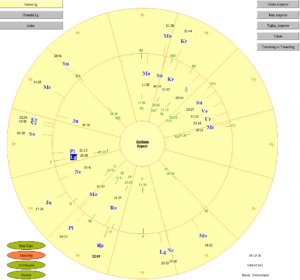
Hofmann is now thirty-six years old, the age of Saturn’s maturation. As it takes the lunar nodes eighteen years to move through the zodiac, age thirty-six also represents the second nodal return of one’s life. The lunar nodes represent the karmic and evolutionary trajectory of the psyche. When they return to their natal placements, the native experiences a “re-tracing” in consciousness that is potentially a rebirth. Hofmann’s second nodal return coincided with his initial ingestion of LSD and, thereby, his discovery of its unique psychic effects.
Yet, the nodal return is only the beginning of the story. Since Hofmann’s natal Ketu is placed near the Midheaven, Ketu’s return re-empowers this conjunction in real-time, allowing this natal characteristic to fully manifest and emerge in consciousness. Hofmann’s description of LSD as his “problem child” is noteworthy for this reason, as his discovery became a karmic burden in light of its use as an intoxicant in the counterculture movement and resultant status as an illegal substance.
The wound of Hofmann’s problem child is evident in the exceptionally exact conjunction of Rahu with Chiron in Leo. Chiron plays an important role in Hofmann’s life, in both the synthesis and re-synthesis of LSD. On the day of his first synthesis, Chiron was conjunct Hofmann’s natal Neptune in Cancer within 1°. Now, on the day of his first conscious ingestion of LSD, Chiron is exactly conjunct with transiting Rahu and conjunct within 1° of Hofmann’s natal Rahu. Thus, Chiron’s conjunction with Rahu has two levels, owing to the simultaneous reality of Hofmann’s nodal return. In Hofmann’s natal chart, Chiron is placed alongside Ketu in Aquarius and, therefore, is on the natal nodal axis. On Bicycle Day, Chiron is placed along the nodal axis during the nodal return, where it conjuncts Rahu on two levels and forms a very dynamic opposition to Hofmann’s natal Chiron in Aquarius (where it is also being influenced by natal and transiting Ketu).
The significant influence of Chiron, both natally and in transit, reveals the therapeutic and healing nature of Hofmann’s discovery. It also shows that LSD would have a deeply healing impact on Hofmann’s own life and, by virtue of the Aquarian placement, on humanity as a whole.
The Sun is Exalted in Aries and exactly conjunct with the 12th house cusp. The Exaltation of the Sun shows the peak of creative energy and the quality of initiation. This is in dynamic relationship to the 12th house, which is seen in Vedic astrology as a moksha house. In an inscription to Hofmann, Aldous Huxley described LSD as the “moksha medicine”. This transit illustrates Hofmann’s ingestion of LSD as an initiatory event and his subsequent discovery of its effects as a spiritually liberating discovery. However, the 12th house also connotes imprisonment, a fate that would fall upon Timothy Leary, the prophet of LSD, and ultimately upon LSD itself when it was made illegal and classified as a “Schedule I” drug.
Mars, the ruler of Aries, is placed in Pisces, where it transits Hofmann’s natal Mars. This is a Mars return, and while not as uncommon as a nodal return, it remains significant. The natal placement of Mars in Pisces indicates a drive for spirituality and a highly intuitive personality. The return of Mars in Pisces re-awakens Hofmann’s natal placement, bringing it to consciousness. Hofmann’s motivation to re-synthesize LSD was based on a “peculiar presentiment”, and his ingestion of it led to a spiritual experience, the likes of which he had once known in childhood. Mars is also in close conjunction with Hofmann’s natal Saturn (within 1°). Mars and Saturn have an interesting dynamic: Mars exalts in the Saturn-ruled sign of Capricorn, but Saturn debilitates in the Mars-ruled sign of Aries. This paradoxical dynamic creates a mutual tension between Mars and Saturn. For this reason, Mars-Saturn conjunctions are often interpreted as causing accidents. As Hofmann recounted, his first ingestion of LSD on April 16 was accidental.
Jupiter is Exalted in Cancer, bringing more energetic focus in the Water signs (as we just saw with Mars in Pisces). In Vedic astrology, the three Water-element signs—Cancer, Scorpio, and Pisces—are associated with the priestly state of consciousness and the aim of moksha. Thus, we see a concentration of energy in Water and Fire elements, the interaction of which is archetypally alchemical.
We will remember that Chiron was placed in Cancer during Hofmann’s first synthesis of LSD, and now Jupiter has reached its climax there. Jupiter moves through the zodiac in twelve years, and therefore, it moves into a new sign of the zodiac every year. Hofmann’s re-synthesis and first psychedelic experience is thus synchronous with the exaltation of Jupiter in Cancer. As Jupiter governs the growth and expansion of consciousness, its quality is most characteristic of the psychedelic experience. Jupiter is also conjunct Neptune, and Chiron was conjunct Neptune during Hofmann’s first synthesis. The conjunction of Jupiter and Neptune is spiritually empowering and points again to the mystical basis of Hofmann’s experimentation.
The movements of Neptune have a curious relationship to Hofmann’s synthesis and re-synthesis. On November 16, 1938, Neptune was transiting Virgo. On October 3, 1942, Neptune entered Libra before beginning a retrograde cycle back into Virgo on April 17, 1943—one day after Hofmann’s accidental dosing of LSD. On April 19, when Hofmann intentionally took LSD for the first time, Neptune was in Virgo again, the same sign it was in when he first synthesized it five years prior. Indeed, retrograde cycles lead to a “re-tracing” of events and, in this case, complete a “magic circle” for Hofmann.
We must note that the Sun and Jupiter are exalted, and Mars is influentially present. According to Chinese five-element theory, Jupiter corresponds to the Wood element, Mars corresponds to the Fire element, and the Sun represents the quality of yang. Hofmann’s experience takes place in the springtime when the Wood element is naturally predominant. Wood corresponds to the Liver/Gallbladder network, and its aperture is in the eyes. Therefore, the Wood element is the source of visionary experience and perspective. The Fire element is closely associated with the spirit because it corresponds to the Heart, the organ regarded as the “seat of the spirit”. The influence of the Fire element is evident in the spiritual quality of Hofmann’s LSD experience.
Uranus is conjunct Venus and Saturn, and all three are transiting Hofmann’s Ascendant and natal Pluto. The natal conjunction of Pluto with the Ascendant is a notable quality of Hofmann’s chart and confers upon him a markedly Dionysian character and purpose. The transit of Uranus in Gemini is critical in Hofmann’s first house, a house most intimately connected with his physical body, constitution, and life path. Outer planet transits are particularly notable when they cross the first, fourth, seventh, or tenth houses—the most personal houses of self, home, marriage, and vocation. Uranus transmits a Promethean impulse, a revolutionary breakthrough in consciousness, a stealing of fire that is a transgression of limit and an opus contra naturum. Fire and flower in hand, we craft a new essence and elixir. Hofmann’s re-synthesis and first ingestion of LSD occurring under this transit signify the most significant personal breakthrough of his life.
Uranus is also in a dynamic relationship with Pluto on two levels—it is transiting Hofmann’s natal Pluto and is squaring the transit of Pluto in Leo. Tarnas discusses this Uranus-Pluto cycle at length, crediting it with catalyzing the counterculture era of the 1960s. On the transit of Uranus in the first house, Robert Hand writes:
The transit of Uranus through the first house is predominantly a drive for freedom. To others it may seem to be a period of pointless rebellion. And indeed, in terms of your old life, you may be acting quite irresponsibly, but if you feel very strongly the need to break free, it is a sign that the change is overdue.
As you change your way of handling the world, you will become open to experiences that you would never have allowed before, and your life may take on a whole new outlook. Certainly this is a good time to explore new kinds of awareness or to encounter astrology, yoga, human potential studies and other consciousness-expanding techniques. The avenues to new perception are open, and if you allow yourself to receive it, you will gain new tools for your future life.
Hand’s analysis rings true for this period in Hofmann’s life, characterized as it was by experimentation with LSD and openness to the psychedelic experience it engenders.
IV. Eleusis and Eleutherios
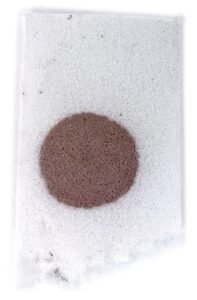
What, then, do we make of this odorless, tasteless, porous, and potent chemical? Is it a drop of immortal nectar or a decanting of godless games? What exactly is this mysterion?
Hofmann’s research into ergot alkaloids led him to the Eleusinian mysteries of ancient Greece. The Eleusinian mysteries were secret religious rites associated with the cult of Demeter and Persephone and held in the city of Eleusis. Hofmann writes:
The Mysteries of Eleusis, which were celebrated annually in the fall, over an interval of approximately 2000 years, from about 1500 BC until the fourth century of our era, were intimately connected with ceremonies and festivals in honor of the god Dionysus. These Mysteries had been founded by Demeter, the goddess of agriculture, in appreciation of the recovery of her daughter, Persephone, who had been abducted by Hades, god of the underworld.
. . . The climax of the yearly ceremonies, which began with a procession from Athens to Eleusis lasting several days, was the concluding ceremony, the initiation, which took place by night. The initiates were forbidden under penalty of death to divulge what they had learned or beheld in the innermost, holiest sanctum of the temple, the telestrion (goal).
. . . In accordance with traditional knowledge, during the climactic ceremony, the initiates imbibed a potion, the kykeon. It is also known that the ingredients of the kykeon were barley extract and mint. Religious and mythological scholars like Karl Kerényi . . . with whom I have collaborated on research into this mysterious potion, are of the opinion that the kykeon constituted an “hallucinogenic” drug. That would make understandable an ecstatic and visionary experience of the Demeter/Persephone myth, in both a comprehensive and timeless reality, as a symbol of the cycle of life and death.
Jonathan Ott notes that Hofmann’s publication The Road to Eleusis: Unveiling the Secret of the Mysteries (1978), co-authored with Gordon Wasson, “conjectured that the kykeon might have acted through an LSD-like aqueous extract of ergot of barley, containing the psychoactive, water-soluble alkaloids”. Fielding notes that Hofmann’s thesis has since been corroborated by archaeological findings:
Decades after Wasson, Ruck, and Albert presented their thesis in The Road to Eleusis, archaeologists found ergot in a Greek ceremonial cup and the dental cavities of an initiate to the Mysteries at Mas Castellar, Spain, in a Temple devoted to Demeter and Persephone.
This understanding is further confirmed by Carod-Artal in the journal article “Psychoactive plants in ancient Greece”, where the author writes:
There is evidence supporting the hypothesis that ergot could have caused the Eleusinian visions. The purple colour of the fungus is associated with Demeter. Furthermore, the ear of grain was the symbol of the Eleusinian Mysteries. An example of Greek pottery from the 5th century BCE shows Demeter and Triptolemus holding a sheaf of grain infected with ergot. Traces of C. purpurea have also been found on the interior of a vessel in a sacred shrine dedicated to Persephone.
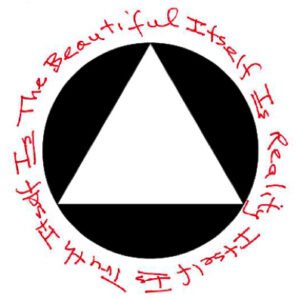
Earlier, Hofmann noted that the Eleusinian Mysteries were associated with Dionysus and the recovery of Persephone from the underworld. Both Dionysus and Hades lend a Plutonian quality to the rites. Indeed, Pluto is archetypally responsible for the experience of “ego-death” on all levels. This observation leads me to characterize LSD as a liberator, or in the Greek language, Eleutherios. The name Eleutherios is an epithet of Dionysus, Eros, and Zeus. In the twentieth century, this name was invoked again by Adi Da, who adopted it as one of many appellations. One of the principal texts in Adi Da’s vast corpus is tilted Eleutherios: The Only Truth That Sets the Heart Free. The text is structured aphoristically and opens with the following verses:
Truth Is the Ultimate Form (or the Inherently Perfect State) of “Knowledge” (if mere knowledge becomes Truth-Realization).
Truth Is That Which, when fully Realized (and, Thus, “Known”, even via the transcending of all conditional knowledge and all conditional experience), Sets you Free from all bondage and all seeking.
Truth Is Eleutherios, the Divine Liberator.
If LSD serves the function of revealing Truth through perception of the Real, then the entheogenic experience sets the Heart free. Perhaps the opus of humanity is not only alchemic but equally entheogenic—a god within a drink or a drop, our birthright a watery palindrome reflected in a looking-glass, beholding our conscious destiny in the peaks and vales of spirit and soul. Then, with open eyes of infinitude in the Heart’s heaven-born gaze, our lips confess the nectarous gospel, the liberating opus of humanity: Reality Itself Is Truth Itself Is the Beautiful Itself.
Support Neeshee by following the original article in his Substack. You can also follow him and send your questions on his Instagram!
Stay safe, sending love!
